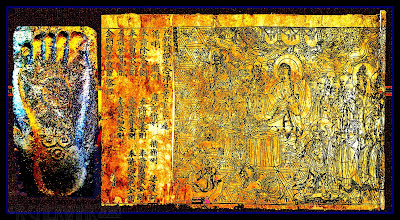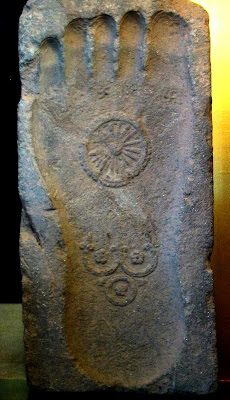

a derivative work made from 2 files from Wikipedia Commons
वज्रच्छेदिका प्रज्ञापारमिता सूत्र
Vajracchedikā Prajñāpāramitā Sūtra
From Wikipedia-
The Buddhist text known around the world as the Diamond Sūtra is a short Mahayana sutra of the Perfection of Wisdom (S. prajna-paramita) genre, which teaches the practice of the avoidance of abiding in extremes of mental attachment. A copy of the Diamond Sutra, found among the Dunhuang manuscripts in the early 20th century, is, in the words of the British Library, "the earliest complete survival of a dated printed book."
Because the Diamond Sūtra can be read in 40-50 minutes, it is often memorized and chanted in Buddhist monasteries. This sūtra has retained significant popularity in the Mahāyāna Buddhist tradition for over a millennium. A list of vivid metaphors for impermanence appears in a popular four-line verse at the end of the sūtra:
All conditioned phenomena
Are like dreams, illusions, bubbles, or shadows;
Like drops of dew, or flashes of lightning;
Thusly should they be contemplated.
Click here for an English translation of the Diamond Sutra

 Buddha footprint
Buddha footprint1st century CE, Gandhara; historical display at Zenyōmitsu-ji (善養密寺), a Buddhist Temple located in the Setagaya ward of Tokyo, Japan. --The bottom symbol is the Triratna or "Three Jewels,", - the top symbol is a dharmachakra. - - This file has been (or is hereby) released into the public domain by its author, PHG at the English Wikipedia project. This applies worldwide. In case this is not legally possible: PHG grants anyone the right to use this work for any purpose, without any conditions, unless such conditions are required by law.
त्रिरत्न
The Three Jewels, also called the Three Treasures, the Three Refuges, or the Triple Gem (triratna)), are the three things that Buddhists take refuge in, and look toward for guidance, in the process known as taking refuge.
The Three Jewels are:
• Buddha
Sanskrit, Pali: The Enlightened or Awakened One - Depending on one's interpretation, can mean the historical Buddha (Shakyamuni) or the Buddha nature—the ideal or highest spiritual potential that exists within all beings;
• Dharma
Sanskrit: The Teaching; Pali: Dhamma - The teachings of the Buddha.
• Sangha
Sanskrit, Pali: The Community - The community of those who have attained enlightenment, who may help a practicing Buddhist to do the same. Also used more broadly to refer to the community of practicing Buddhists.
धर्मचक्र
Click here for or more on the Dharmachakra symbol and Dharma.
see also:
• More about Buddhism on whats more blog
@ Master of the Shakuhachi#zen
• More about the Diamond Sutra at Wikipedia
• English translation of the Diamond Sutra
• About Buddhism at Wikipedia


















